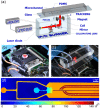Frugal Droplet Microfluidics Using Consumer Opto-Electronics
- PMID: 27560139
- PMCID: PMC4999286
- DOI: 10.1371/journal.pone.0161490
Frugal Droplet Microfluidics Using Consumer Opto-Electronics
Abstract
The maker movement has shown how off-the-shelf devices can be combined to perform operations that, until recently, required expensive specialized equipment. Applying this philosophy to microfluidic devices can play a fundamental role in disseminating these technologies outside specialist labs and into industrial use. Here we show how nanoliter droplets can be manipulated using a commercial DVD writer, interfaced with an Arduino electronic controller. We couple the optical setup with a droplet generation and manipulation device based on the "confinement gradients" approach. This device uses regions of different depths to generate and transport the droplets, which further simplifies the operation and reduces the need for precise flow control. The use of robust consumer electronics, combined with open source hardware, leads to a great reduction in the price of the device, as well as its footprint, without reducing its performance compared with the laboratory setup.
Conflict of interest statement
CNB is an inventor on three patents, owned by Ecole Polytechnique and the CNRS, that are related to different aspects of this work: WO 2006/018490 \Microuidic circuit with an active component". WO 2011/038475 \Microuidic circuit". WO 2011/121220 \Device for forming drops in a microuidic circuit". This does not alter the authors’ adherence to PLOS ONE policies on sharing data and materials.
Figures






References
MeSH terms
Substances
Grants and funding
LinkOut - more resources
Full Text Sources
Other Literature Sources

